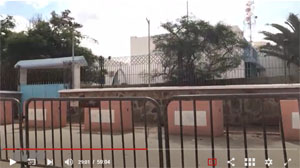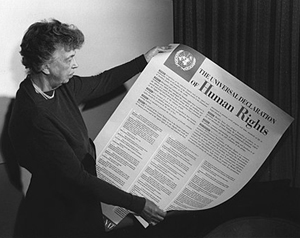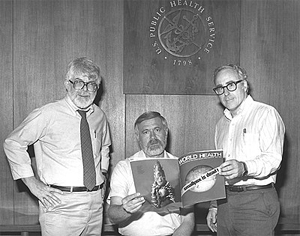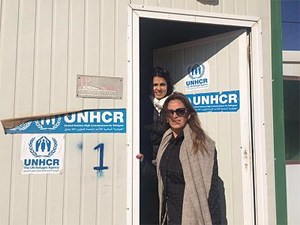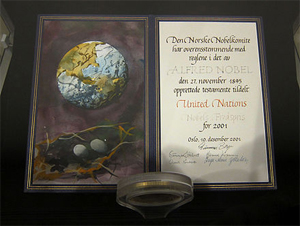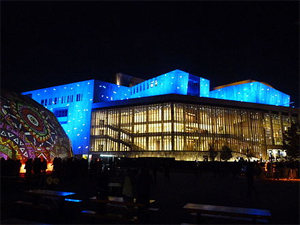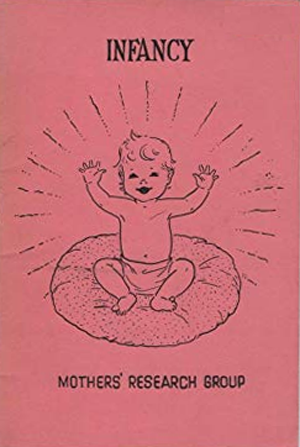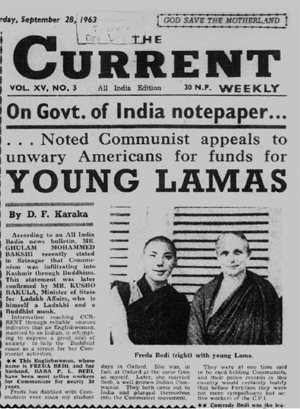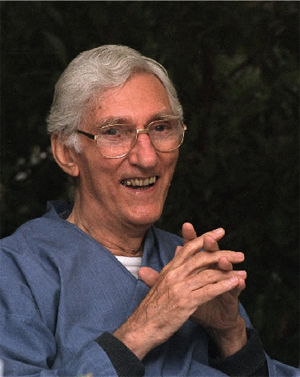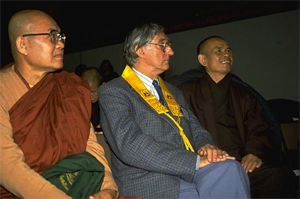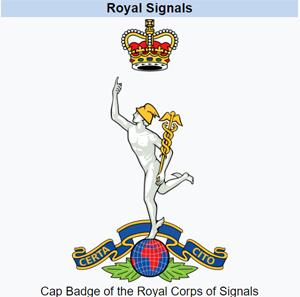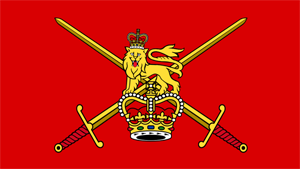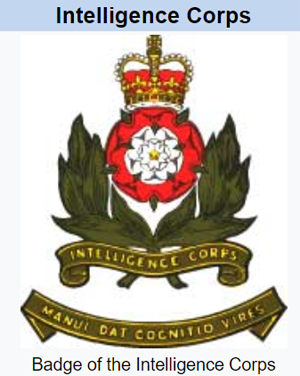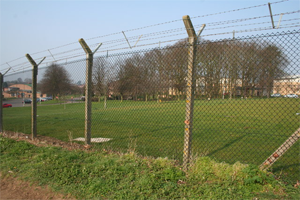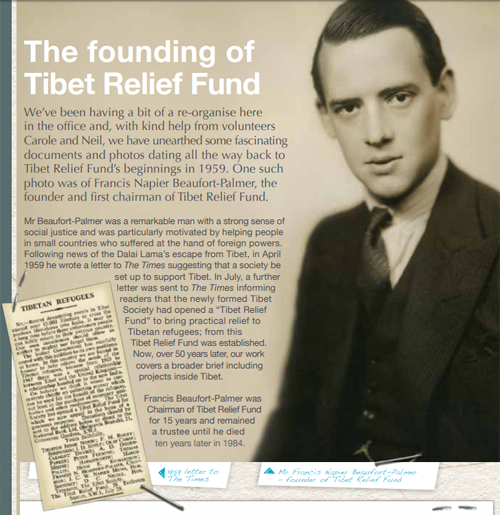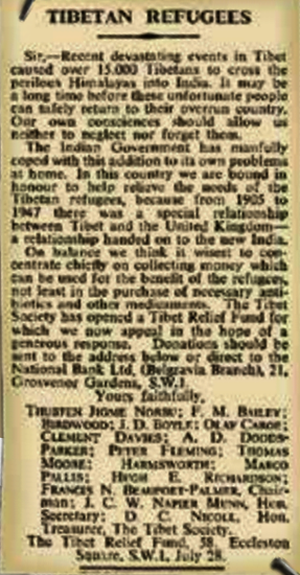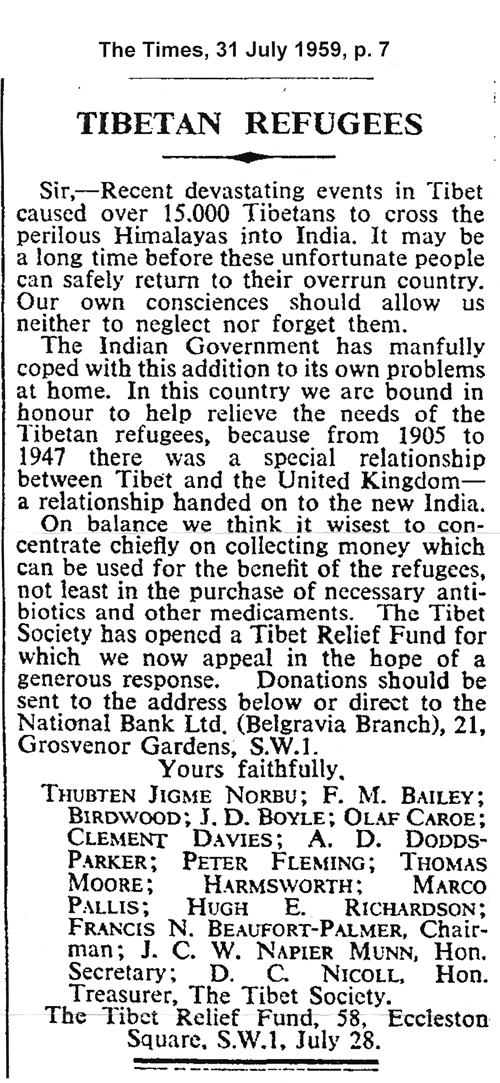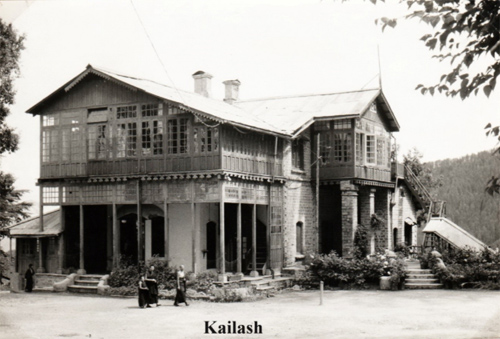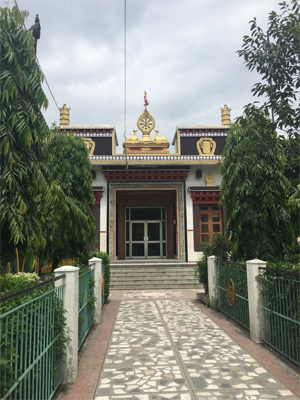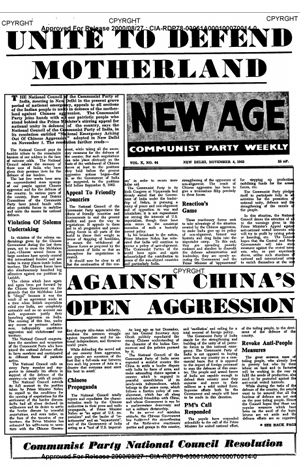United Nations
by Wikipedia
Accessed: 3/6/20
AMY GOODMAN: Western Sahara — the center of a four-decades-long struggle for independence from Morocco, its neighbor to the north. Morocco has occupied the territory since 1975 in defiance of the United Nations and the international community....
In 1991, the U.N. sponsored a ceasefire and promised Sahrawis a referendum on self-determination, organized by its peacekeeping mission known as MINURSO. Since then, Morocco has blocked attempts to organize the vote, and the U.N. Security Council has refused to implement its own referendum plan or allow MINURSO to monitor the human rights situation in the territory...
I quote from a Human Rights Watch report titled “Keeping It Secret,” about Morocco’s efforts to block access to MINURSO. That’s the U.N. mission for a referendum on the status of Western Sahara:Opportunities for independent outsiders to observe and analyze the identification process are strictly limited. A U.N. rule limits the presence of representatives of non-governmental organizations and journalists in the MINURSO identification center in Laayoune to thirty minutes, a period that is too brief to permit meaningful observation of a complex process. In addition, MINURSO staff members, including military observers, are subjected to constant surveillance by Morocco. This, and internal pressure from MINURSO, made them reluctant, even frightened, to speak to our organization, except on the explicit condition of anonymity. Moroccan security forces tried to prevent Human Rights Watch from entering the U.N. headquarters, stating that entry was forbidden to non-MINURSO staff unless it had been cleared with local Moroccan authorities first. Moroccan authorities' harassment of Human Rights Watch, as well as their strict surveillance of its activities, impeded the organization's ability to conduct a thorough investigation of human rights abuses in the Moroccan-controlled Western Sahara.
We pass the United Nations’ MINURSO compound, where just over 200 U.N. peacekeepers monitor the 1991 ceasefire between Morocco and the Polisario, but are legally prevented from intervening to stop human rights abuses.
-- 4 Days in Western Sahara: A Rare Look Inside Africa’s Last Colony as U.S. Recognizes Moroccan Occupation, by Amy Goodman, DemocracyNow
United Nations
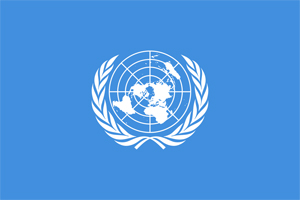
Flag of United Nations Arabic: منظمة الأمم المتحدة Chinese: 联合国组织 French: Organisation des Nations unies Russian: Организация Объединённых Наций Spanish: Organización de las Naciones Unidas
Flag
Emblem of United Nations Arabic: منظمة الأمم المتحدة Chinese: 联合国组织 French: Organisation des Nations unies Russian: Организация Объединённых Наций Spanish: Organización de las Naciones Unidas
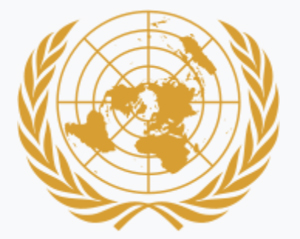
Emblem
Headquarters New York City (international territory)
Official languages
ArabicChineseEnglishFrenchRussianSpanish[1]
Type Intergovernmental organization
Membership 193 member states
2 observer states
Leaders
• Secretary‑General
António Guterres
• Deputy Secretary-General
Amina J. Mohammed
• General Assembly President
Tijjani Muhammad-Bande
• Economic and Social Council President
Mona Juul
• Security Council President
Dang Dinh Quy
Establishment
• UN Charter signed
26 June 1945 (74 years ago)
• Charter entered into force
24 October 1945 (74 years ago)
Website
UN.org
UN.int
The United Nations (UN) is an intergovernmental organization that aims to maintain international peace and security, develop friendly relations among nations, achieve international cooperation, and be a center for harmonizing the actions of nations.[2] It is the largest, most familiar, most internationally represented and most powerful intergovernmental organization in the world. The UN is headquartered on international territory in New York City; other main offices are in Geneva, Nairobi, Vienna and The Hague.
The UN was established after World War II with the aim of preventing future wars, succeeding the ineffective League of Nations.[3] On 25 April 1945, 50 governments met in San Francisco for a conference and started drafting the UN Charter, which was adopted on 25 June 1945 and took effect on 24 October 1945, when the UN began operations. Pursuant to the Charter, the organization's objectives include maintaining international peace and security, protecting human rights, delivering humanitarian aid, promoting sustainable development, and upholding international law.[4] At its founding, the UN had 51 member states; this number grew to 193 in 2011,[5] representing the vast majority of the world's sovereign states.
The organization's mission to preserve world peace was complicated in its early decades by the Cold War between the United States and Soviet Union and their respective allies. Its missions have consisted primarily of unarmed military observers and lightly armed troops with primarily monitoring, reporting and confidence-building roles.[6] UN membership grew significantly following widespread decolonization beginning in the 1960s. Since then, 80 former colonies have gained independence, including 11 trust territories that had been monitored by the Trusteeship Council.[7] By the 1970s, the UN's budget for economic and social development programmes far outstripped its spending on peacekeeping. After the end of the Cold War, the UN shifted and expanded its field operations, undertaking a wide variety of complex tasks.[8]
The UN has six principal organs: the General Assembly; the Security Council; the Economic and Social Council (ECOSOC); the Trusteeship Council; the International Court of Justice; and the UN Secretariat. The UN System includes a multitude of specialized agencies, such as the World Bank Group, the World Health Organization, the World Food Programme, UNESCO, and UNICEF. Additionally, non-governmental organizations may be granted consultative status with ECOSOC and other agencies to participate in the UN's work. The UN's chief administrative officer is the Secretary-General, currently Portuguese politician and diplomat António Guterres, since 1 January 2017. The organization is financed by assessed and voluntary contributions from its member states.
The UN, its officers, and its agencies have won many Nobel Peace Prizes, though other evaluations of its effectiveness have been mixed. Some commentators believe the organization to be an important force for peace and human development, while others have called it ineffective, biased, or corrupt.
History
Main article: History of the United Nations
Background
In the century prior to the UN's creation, several international treaty organizations such as the International Committee of the Red Cross were formed to ensure protection and assistance for victims of armed conflict and strife.[9] In 1914, a political assassination in Sarajevo set off a chain of events that led to the outbreak of World War I. As more and more young men were sent down into the trenches, influential voices in the United States and Britain began calling for the establishment of a permanent international body to maintain peace in the postwar world. President Woodrow Wilson became a vocal advocate of this concept, and in 1918 he included a sketch of the international body in his 14-point proposal to end the war. In November 1918, the Central Powers agreed to an armistice to halt the killing in World War I. Two months later, the Allies met with Germany and Austria-Hungary at Versailles to hammer out formal peace terms. President Wilson wanted peace, but the United Kingdom and France disagreed, forcing harsh war reparations on their former enemies. The League of Nations was approved, and in the summer of 1919 Wilson presented the Treaty of Versailles and the Covenant of the League of Nations to the US Senate for ratification. On 10 January 1920, the League of Nations formally came into being when the Covenant of the League of Nations, ratified by 42 nations in 1919, took effect.[10] However, at some point the League became ineffective when it failed to act against the Japanese invasion of Manchuria as in February 1933, 40 nations voted for Japan to withdraw from Manchuria but Japan voted against it and walked out of the League instead of withdrawing from Manchuria.[11] It also failed against the Second Italo-Ethiopian War despite trying to talk to Benito Mussolini as he used the time to send an army to Africa, so the League had a plan for Mussolini to just take a part of Ethiopia, but he ignored the League and invaded Ethiopia, the League tried putting sanctions on Italy, but Italy had already conquered Ethiopia and the League had failed.[12] After Italy conquered Ethiopia, Italy and other nations left the league. But all of them realized that it had failed and they began to re-arm as fast as possible. During 1938, Britain and France tried negotiating directly with Hitler but this failed in 1939 when Hitler invaded Czechoslovakia. When war broke out in 1939, the League closed down and its headquarters in Geneva remained empty throughout the war.[13] Although the United States never joined the League, the country did support its economic and social missions through the work of private philanthropies and by sending representatives to committees.
1942 "Declaration of United Nations" by the Allies of World War II
Main article: Declaration by United Nations
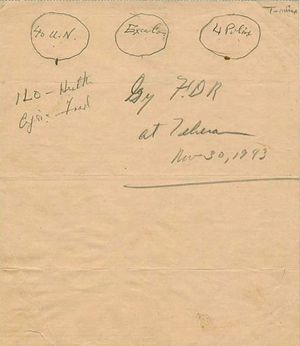
1943 sketch by Franklin Roosevelt of the UN original three branches: The Four Policemen, an executive branch, and an international assembly of forty UN member states
The earliest concrete plan for a new world organization began under the aegis of the U.S. State Department in 1939.[14] The text of the "Declaration by United Nations" was drafted at the White House on 29 December 1941, by President Franklin D. Roosevelt, Prime Minister Winston Churchill, and Roosevelt aide Harry Hopkins. It incorporated Soviet suggestions, but left no role for France. "Four Policemen" was coined to refer to four major Allied countries, United States, United Kingdom, Soviet Union, and Republic of China, which emerged in the Declaration by United Nations.[15] Roosevelt first coined the term United Nations to describe the Allied countries.[a] "On New Year's Day 1942, President Roosevelt, Prime Minister Churchill, Maxim Litvinov, of the USSR, and T. V. Soong, of China, signed a short document which later came to be known as the United Nations Declaration and the next day the representatives of twenty-two other nations added their signatures."[16] The term United Nations was first officially used when 26 governments signed this Declaration. One major change from the Atlantic Charter was the addition of a provision for religious freedom, which Stalin approved after Roosevelt insisted.[17][18] By 1 March 1945, 21 additional states had signed.[19]
A JOINT DECLARATION BY THE UNITED STATES OF AMERICA, THE UNITED KINGDOM OF GREAT BRITAIN AND NORTHERN IRELAND, THE UNION OF SOVIET SOCIALIST REPUBLICS, CHINA, AUSTRALIA, BELGIUM, CANADA, COSTA RICA, CUBA, CZECHOSLOVAKIA, DOMINICAN REPUBLIC, EL SALVADOR, GREECE, GUATEMALA, HAITI, HONDURAS, INDIA, LUXEMBOURG, NETHERLANDS, NEW ZEALAND, NICARAGUA, NORWAY, PANAMA, POLAND, SOUTH AFRICA, YUGOSLAVIA
The Governments signatory hereto,
Having subscribed to a common program of purposes and principles embodied in the Joint Declaration of the President of the United States of America and the Prime Minister of Great Britain dated August 14, 1941, known as the Atlantic Charter,
Being convinced that complete victory over their enemies is essential to defend life, liberty, independence and religious freedom, and to preserve human rights and justice in their own lands as well as in other lands, and that they are now engaged in a common struggle against savage and brutal forces seeking to subjugate the world,
DECLARE:
1. Each Government pledges itself to employ its full resources, military or economic, against those members of the Tripartite Pact and its adherents with which such government is at war.
2. Each Government pledges itself to cooperate with the Governments signatory hereto and not to make a separate armistice or peace with the enemies.
The foregoing declaration may be adhered to by other nations which are, or which may be, rendering material assistance and contributions in the struggle for victory over Hitlerism.
— The Washington Conference 1941–1942
During the war, "the United Nations" became the official term for the Allies. To join, countries had to sign the Declaration and declare war on the Axis.[20]
Founding
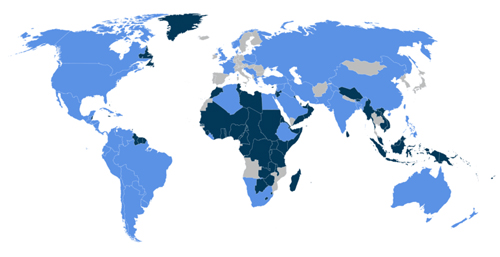
The UN in 1945: founding members in light blue, protectorates and territories of the founding members in dark blue
The UN was formulated and negotiated among the delegations from the Allied Big Four (the United States, the United Kingdom, the Soviet Union and China) at the Dumbarton Oaks Conference from 21 September 1944 to 7 October 1944 and they agreed on the aims, structure and functioning of the UN.[21][22][23] After months of planning, the UN Conference on International Organization opened in San Francisco, 25 April 1945, attended by 50 governments and a number of non-governmental organizations involved in drafting the UN Charter.[24][25][26] "The heads of the delegations of the sponsoring countries took turns as chairman of the plenary meetings: Anthony Eden, of Britain, Edward Stettinius, of the United States, T. V. Soong, of China, and Vyacheslav Molotov, of the Soviet Union. At the later meetings, Lord Halifax deputized for Mister Eden, Wellington Koo for T. V. Soong, and Mister Gromyko for Mister Molotov."[27] The UN officially came into existence 24 October 1945, upon ratification of the Charter by the five permanent members of the Security Council—France, the Republic of China, the Soviet Union, the UK and the US—and by a majority of the other 46 signatories.[28]
The first meetings of the General Assembly, with 51 nations represented,[ b] and the Security Council took place in Methodist Central Hall, Westminster, London beginning on 10 January 1946.[28] The General Assembly selected New York City as the site for the headquarters of the UN, construction began on 14 September 1948 and the facility was completed on 9 October 1952. Its site—like UN headquarters buildings in Geneva, Vienna, and Nairobi—is designated as international territory.[31] The Norwegian Foreign Minister, Trygve Lie, was elected as the first UN Secretary-General.[28]
Cold War era
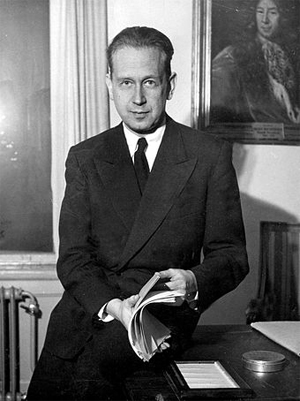
Dag Hammarskjöld was a particularly active Secretary-General from 1953 until his death in 1961.
Though the UN's primary mandate was peacekeeping, the division between the US and USSR often paralysed the organization, generally allowing it to intervene only in conflicts distant from the Cold War.[32] Two notable exceptions were a Security Council resolution on 7 July 1950 authorizing a US-led coalition to repel the North Korean invasion of South Korea, passed in the absence of the USSR,[28][33] and the signing of the Korean Armistice Agreement in 27 July 1953.[34]
On 29 November 1947, the General Assembly approved a resolution to partition Palestine, approving the creation of the state of Israel.[35] Two years later, Ralph Bunche, a UN official, negotiated an armistice to the resulting conflict.[36] On 7 November 1956, the first UN peacekeeping force was established to end the Suez Crisis;[37] however, the UN was unable to intervene against the USSR's simultaneous invasion of Hungary following that country's revolution.[38]
On 14 July 1960, the UN established United Nations Operation in the Congo (UNOC), the largest military force of its early decades, to bring order to the breakaway State of Katanga, restoring it to the control of the Democratic Republic of the Congo by 11 May 1964.[39] While travelling to meet rebel leader Moise Tshombe during the conflict, Dag Hammarskjöld, often named as one of the UN's most effective Secretaries-General,[40] died in a plane crash; months later he was posthumously awarded the Nobel Peace Prize.[41] In 1964, Hammarskjöld's successor, U Thant, deployed the UN Peacekeeping Force in Cyprus, which would become one of the UN's longest-running peacekeeping missions.[42]
With the spread of decolonization in the 1960s, the organization's membership saw an influx of newly independent nations. In 1960 alone, 17 new states joined the UN, 16 of them from Africa.[37] On 25 October 1971, with opposition from the United States, but with the support of many Third World nations, the mainland, communist People's Republic of China was given the Chinese seat on the Security Council in place of the Republic of China that occupied Taiwan; the vote was widely seen as a sign of waning US influence in the organization.[43] Third World nations organized into the Group of 77 coalition under the leadership of Algeria, which briefly became a dominant power at the UN.[44] On 10 November 1975, a bloc comprising the USSR and Third World nations passed a resolution, over strenuous US and Israeli opposition, declaring Zionism to be racism; the resolution was repealed on 16 December 1991, shortly after the end of the Cold War.[45][46]
With an increasing Third World presence and the failure of UN mediation in conflicts in the Middle East, Vietnam, and Kashmir, the UN increasingly shifted its attention to its ostensibly secondary goals of economic development and cultural exchange.[47] By the 1970s, the UN budget for social and economic development was far greater than its peacekeeping budget.
Post-Cold War
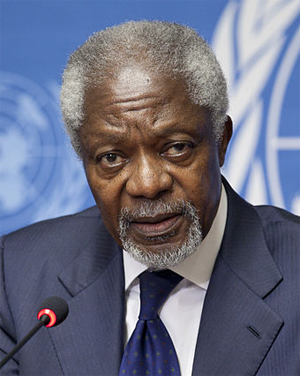
Kofi Annan, Secretary-General from 1997 to 2006
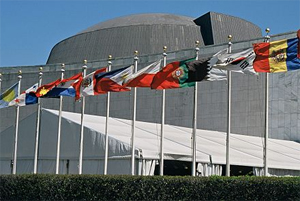
Flags of member nations at the United Nations Headquarters, seen in 2007
After the Cold War, the UN saw a radical expansion in its peacekeeping duties, taking on more missions in ten years than it had in the previous four decades.[48] Between 1988 and 2000, the number of adopted Security Council resolutions more than doubled, and the peacekeeping budget increased more than tenfold.[49][50][51] The UN negotiated an end to the Salvadoran Civil War, launched a successful peacekeeping mission in Namibia, and oversaw democratic elections in post-apartheid South Africa and post-Khmer Rouge Cambodia.[52] In 1991, the UN authorized a US-led coalition that repulsed the Iraqi invasion of Kuwait.[53] Brian Urquhart, Under-Secretary-General from 1971 to 1985, later described the hopes raised by these successes as a "false renaissance" for the organization, given the more troubled missions that followed.[54]
Though the UN Charter had been written primarily to prevent aggression by one nation against another, in the early 1990s the UN faced a number of simultaneous, serious crises within nations such as Somalia, Haiti, Mozambique, and the former Yugoslavia.[55] The UN mission in Somalia was widely viewed as a failure after the US withdrawal following casualties in the Battle of Mogadishu, and the UN mission to Bosnia faced "worldwide ridicule" for its indecisive and confused mission in the face of ethnic cleansing.[56] In 1994, the UN Assistance Mission for Rwanda failed to intervene in the Rwandan genocide amid indecision in the Security Council.[57]
Beginning in the last decades of the Cold War, American and European critics of the UN condemned the organization for perceived mismanagement and corruption.[58] In 1984, US President Ronald Reagan, withdrew his nation's funding from United Nations Educational, Scientific and Cultural Organization (UNESCO) over allegations of mismanagement, followed by the UK and Singapore.[59][60] Boutros Boutros-Ghali, Secretary-General from 1992 to 1996, initiated a reform of the Secretariat, reducing the size of the organization somewhat.[61][62] His successor, Kofi Annan (1997–2006), initiated further management reforms in the face of threats from the US to withhold its UN dues.[62]
From the late 1990s to the early 2000s, international interventions authorized by the UN took a wider variety of forms. The UN mission in the Sierra Leone Civil War of 1991–2002 was supplemented by British Royal Marines, and the invasion of Afghanistan in 2001 was overseen by NATO.[63] In 2003, the United States invaded Iraq despite failing to pass a UN Security Council resolution for authorization, prompting a new round of questioning of the organization's effectiveness.[64] Under the eighth Secretary-General, Ban Ki-moon, the UN intervened with peacekeepers in crises such as the War in Darfur in Sudan and the Kivu conflict in the Democratic Republic of Congo and sent observers and chemical weapons inspectors to the Syrian Civil War.[65] In 2013, an internal review of UN actions in the final battles of the Sri Lankan Civil War in 2009 concluded that the organization had suffered "systemic failure".[66] In 2010, the organization suffered the worst loss of life in its history, when 101 personnel died in the Haiti earthquake[67]
The Millennium Summit was held in 2000 to discuss the UN's role in the 21st century.[68] The three day meeting was the largest gathering of world leaders in history, and culminated in the adoption by all member states of the Millennium Development Goals (MDGs), a commitment to achieve international development in areas such as poverty reduction, gender equality, and public health. Progress towards these goals, which were to be met by 2015, was ultimately uneven. The 2005 World Summit reaffirmed the UN's focus on promoting development, peacekeeping, human rights, and global security.[69] The Sustainable Development Goals were launched in 2015 to succeed the Millennium Development Goals.[70]
In addition to addressing global challenges, the UN has sought to improve its accountability and democratic legitimacy by engaging more with civil society and fostering a global constituency.[71] In an effort to enhance transparency, in 2016 the organization held its first public debate between candidates for Secretary-General.[72] On 1 January 2017, Portuguese diplomat António Guterres, who previously served as UN High Commissioner for Refugees, became the ninth Secretary-General. Guterres has highlighted several key goals for his administration, including an emphasis on diplomacy for preventing conflicts, more effective peacekeeping efforts, and streamlining the organization to be more responsive and versatile to global needs.[73]
Structure
Main article: United Nations System
The UN system is based on five principal organs: the General Assembly, the Security Council, the Economic and Social Council (ECOSOC), the International Court of Justice and the UN Secretariat.[74] A sixth principal organ, the Trusteeship Council, suspended operations on 1 November 1994, upon the independence of Palau, the last remaining UN trustee territory.[75]
Four of the five principal organs are located at the main UN Headquarters in New York City.[76] The International Court of Justice is located in The Hague, while other major agencies are based in the UN offices at Geneva,[77] Vienna,[78] and Nairobi.[79] Other UN institutions are located throughout the world. The six official languages of the UN, used in intergovernmental meetings and documents, are Arabic, Chinese, English, French, Russian, and Spanish.[80] On the basis of the Convention on the Privileges and Immunities of the United Nations, the UN and its agencies are immune from the laws of the countries where they operate, safeguarding the UN's impartiality with regard to the host and member countries.[81]
Below the six organs sit, in the words of the author Linda Fasulo, "an amazing collection of entities and organizations, some of which are actually older than the UN itself and operate with almost complete independence from it".[82] These include specialized agencies, research and training institutions, programmes and funds, and other UN entities.[83]
The UN obeys the Noblemaire principle, which is binding on any organization that belongs to the UN system. This principle calls for salaries that will draw and keep citizens of countries where salaries are highest, and also calls for equal pay for work of equal value independent of the employee's nationality.[84][85] In practice, the ICSC takes reference to the highest-paying national civil service.[86] Staff salaries are subject to an internal tax that is administered by the UN organizations.[84][87]
Principal organs of the United Nations [88]
UN General Assembly
— Deliberative assembly of all UN member states —
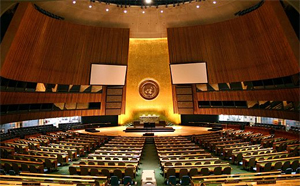
• May resolve non-compulsory recommendations to states or suggestions to the Security Council (UNSC);
• Decides on the admission of new members, following proposal by the UNSC;
• Adopts the budget;
• Elects the non-permanent members of the UNSC; all members of ECOSOC; the UN Secretary General (following his/her proposal by the UNSC); and the fifteen judges of the International Court of Justice (ICJ). Each country has one vote.
UN Secretariat
— Administrative organ of the UN —
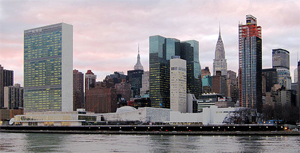
• Supports the other UN bodies administratively (for example, in the organization of conferences, the writing of reports and studies and the preparation of the budget);
• Its chairperson – the UN Secretary General – is elected by the General Assembly for a five-year mandate and is the UN's foremost representative.
International Court of Justice
— Universal court for international law —
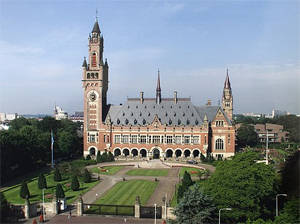
• Decides disputes between states that recognize its jurisdiction;
• Issues legal opinions;
• Renders judgment by relative majority. Its fifteen judges are elected by the UN General Assembly for nine-year terms.
UN Security Council
— For international security issues —
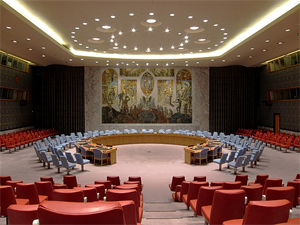
• Responsible for the maintenance of international peace and security;
• May adopt compulsory resolutions;
• Has fifteen members: five permanent members with veto power and ten elected members.
UN Economic and Social Council
— For global economic and social affairs —
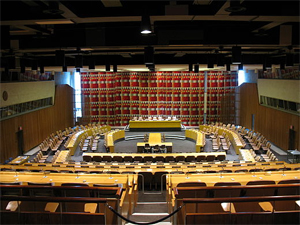
• Responsible for co-operation between states as regards economic and social matters;
• Co-ordinates co-operation between the UN's numerous specialized agencies;
• Has 54 members, elected by the General Assembly to serve staggered three-year mandates.
UN Trusteeship Council
— For administering trust territories (currently inactive) —
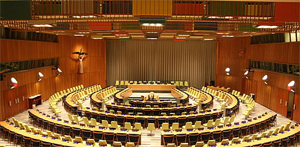
• Was originally designed to manage colonial possessions that were former League of Nations mandates;
• Has been inactive since 1994, when Palau, the last trust territory, attained independence.
General Assembly
Main article: United Nations General Assembly
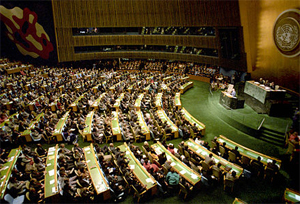
Mikhail Gorbachev, Soviet general secretary, addressing the UN General Assembly in December 1988
The General Assembly is the main deliberative assembly of the UN. Composed of all UN member states, the assembly meets in regular yearly sessions, but emergency sessions can also be called.[89] The assembly is led by a president, elected from among the member states on a rotating regional basis, and 21 vice-presidents.[90] The first session convened 10 January 1946 in the Methodist Central Hall in London and included representatives of 51 nations.[28]
When the General Assembly decides on important questions such as those on peace and security, admission of new members and budgetary matters, a two-thirds majority of those present and voting is required.[91][92] All other questions are decided by a majority vote. Each member country has one vote. Apart from approval of budgetary matters, resolutions are not binding on the members. The Assembly may make recommendations on any matters within the scope of the UN, except matters of peace and security that are under consideration by the Security Council.[89]
Draft resolutions can be forwarded to the General Assembly by its six main committees:[93]
• First Committee (Disarmament and International Security)
• Second Committee (Economic and Financial)
• Third Committee (Social, Humanitarian, and Cultural)
• Fourth Committee (Special Political and Decolonization)
• Fifth Committee (Administrative and Budgetary)
• Sixth Committee (Legal)
As well as by the following two committees:
• General Committee – a supervisory committee consisting of the assembly's president, vice-president, and committee heads
• Credentials Committee – responsible for determining the credentials of each member nation's UN representatives
Security Council
Main article: United Nations Security Council
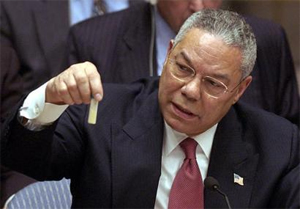
Colin Powell, the US Secretary of State, demonstrates a vial with alleged Iraqi chemical weapon probes to the UN Security Council on Iraq war hearings, 5 February 2003
The Security Council is charged with maintaining peace and security among countries. While other organs of the UN can only make "recommendations" to member states, the Security Council has the power to make binding decisions that member states have agreed to carry out, under the terms of Charter Article 25.[94] The decisions of the Council are known as United Nations Security Council resolutions.[95]
The Security Council is made up of fifteen member states, consisting of five permanent members—China, France, Russia, the United Kingdom, and the United States—and ten non-permanent members elected for two-year terms by the General Assembly (with end of term date)—Belgium (term ends 2020), Côte d'Ivoire (2019), Dominican Republic (2020), Equatorial Guinea (2019), Germany (2020), Indonesia (2020), Kuwait (2019), Peru (2019), Poland (2019), and South Africa (2020).[96] The five permanent members hold veto power over UN resolutions, allowing a permanent member to block adoption of a resolution, though not debate. The ten temporary seats are held for two-year terms, with five member states per year voted in by the General Assembly on a regional basis.[97] The presidency of the Security Council rotates alphabetically each month.[98]
UN Secretariat
Main articles: United Nations Secretariat and Secretary-General of the United Nations
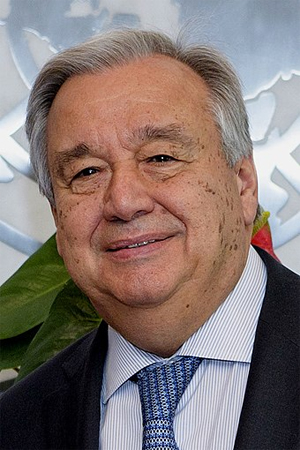
Current secretary-general, António Guterres
The UN Secretariat is headed by the secretary-general, assisted by the deputy secretary-general and a staff of international civil servants worldwide.[99] It provides studies, information, and facilities needed by UN bodies for their meetings. It also carries out tasks as directed by the Security Council, the General Assembly, the Economic and Social Council, and other UN bodies.[100]
The secretary-general acts as the de facto spokesperson and leader of the UN. The position is defined in the UN Charter as the organization's "chief administrative officer".[101] Article 99 of the charter states that the secretary-general can bring to the Security Council's attention "any matter which in his opinion may threaten the maintenance of international peace and security", a phrase that Secretaries-General since Trygve Lie have interpreted as giving the position broad scope for action on the world stage.[102] The office has evolved into a dual role of an administrator of the UN organization and a diplomat and mediator addressing disputes between member states and finding consensus to global issues.[103]
The secretary-general is appointed by the General Assembly, after being recommended by the Security Council, where the permanent members have veto power. There are no specific criteria for the post, but over the years it has become accepted that the post shall be held for one or two terms of five years.[104] The current Secretary-General is António Guterres, who replaced Ban Ki-moon in 2017.
Secretaries-General of the United Nations[105]
No. / Name / Country of origin / Took office / Left office / Notes
1 Trygve Lie Norway 2 February 1946 10 November 1952 Resigned
2 Dag Hammarskjöld Sweden 10 April 1953 18 September 1961 Died in office
3 U Thant Burma 30 November 1961 31 December 1971 First non-European to hold office
4 Kurt Waldheim Austria 1 January 1972 31 December 1981
5 Javier Pérez de Cuéllar Peru 1 January 1982 31 December 1991
6 Boutros Boutros-Ghali Egypt 1 January 1992 31 December 1996 Served for the shortest time
7 Kofi Annan Ghana 1 January 1997 31 December 2006
8 Ban Ki-moon South Korea 1 January 2007 31 December 2016
9 António Guterres Portugal 1 January 2017 Incumbent
International Court of Justice
Main article: International Court of Justice
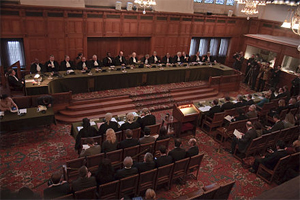
The court ruled that Kosovo's unilateral declaration of independence from Serbia in 2008 did not violate international law.
The International Court of Justice (ICJ), located in The Hague, in the Netherlands, is the primary judicial organ of the UN. Established in 1945 by the UN Charter, the Court began work in 1946 as the successor to the Permanent Court of International Justice. The ICJ is composed of 15 judges who serve 9-year terms and are appointed by the General Assembly; every sitting judge must be from a different nation.[106][107]
It is based in the Peace Palace in The Hague, sharing the building with the Hague Academy of International Law, a private centre for the study of international law. The ICJ's primary purpose is to adjudicate disputes among states. The court has heard cases related to war crimes, illegal state interference, ethnic cleansing, and other issues.[108] The ICJ can also be called upon by other UN organs to provide advisory opinions.[106] It is the only organ that is not located in New York.
Economic and Social Council
Main article: United Nations Economic and Social Council
The Economic and Social Council (ECOSOC) assists the General Assembly in promoting international economic and social co-operation and development. ECOSOC has 54 members, which are elected by the General Assembly for a three-year term. The president is elected for a one-year term and chosen amongst the small or middle powers represented on ECOSOC. The council has one annual meeting in July, held in either New York or Geneva. Viewed as separate from the specialized bodies it co-ordinates, ECOSOC's functions include information gathering, advising member nations, and making recommendations.[109][110] Owing to its broad mandate of co-ordinating many agencies, ECOSOC has at times been criticized as unfocused or irrelevant.[109][111]
ECOSOC's subsidiary bodies include the United Nations Permanent Forum on Indigenous Issues, which advises UN agencies on issues relating to indigenous peoples; the United Nations Forum on Forests, which co-ordinates and promotes sustainable forest management; the United Nations Statistical Commission, which co-ordinates information-gathering efforts between agencies; and the Commission on Sustainable Development, which co-ordinates efforts between UN agencies and NGOs working towards sustainable development. ECOSOC may also grant consultative status to non-governmental organizations;[109] by 2004, more than 2,200 organizations had received this status.[112]
Specialized agencies
Main article: List of specialized agencies of the United Nations
The UN Charter stipulates that each primary organ of the United Nations can establish various specialized agencies to fulfil its duties.[113] Some best-known agencies are the International Atomic Energy Agency, the Food and Agriculture Organization, UNESCO (United Nations Educational, Scientific and Cultural Organization), the World Bank, and the World Health Organization (WHO). The UN performs most of its humanitarian work through these agencies. Examples include mass vaccination programmes (through WHO), the avoidance of famine and malnutrition (through the work of the WFP), and the protection of vulnerable and displaced people (for example, by UNHCR).[114]
Organizations and specialized agencies of the United Nations
No. / Acronym / Agency / Headquarters / Head / Established in
1 FAO Food and Agriculture Organization Italy Rome, Italy China Qu Dongyu 1945
2 IAEA International Atomic Energy Agency Austria Vienna, Austria Argentina Rafael Grossi 1957
3 ICAO International Civil Aviation Organization Canada Montreal, Quebec, Canada China Fang Liu 1947
4 IFAD International Fund for Agricultural Development Italy Rome, Italy Togo Gilbert Houngbo 1977
5 ILO International Labour Organization Switzerland Geneva, Switzerland United Kingdom Guy Ryder 1946 (1919)
6 IMO International Maritime Organization United Kingdom London, United Kingdom South Korea Kitack Lim 1948
7 IMF International Monetary Fund United States Washington, D.C., United States Bulgaria Kristalina Georgieva 1945 (1944)
8 ITU International Telecommunication Union Switzerland Geneva, Switzerland China Houlin Zhao 1947 (1865)
9 UNESCO United Nations Educational, Scientific and Cultural Organization France Paris, France France Audrey Azoulay 1946
10 UNIDO United Nations Industrial Development Organization Austria Vienna, Austria China Li Yong 1967
11 UNWTO World Tourism Organization Spain Madrid, Spain Georgia (country) Zurab Pololikashvili 1974
12 UPU Universal Postal Union Switzerland Bern, Switzerland Kenya Bishar Abdirahman Hussein 1947 (1874)
13 WBG World Bank Group United States Washington, D.C., United States United States David Malpass (President) 1945 (1944)
14 WFP World Food Programme Italy Rome, Italy United States David Beasley 1963
15 WHO World Health Organization Switzerland Geneva, Switzerland Ethiopia Tedros Adhanom 1948
16 WIPO World Intellectual Property Organization Switzerland Geneva, Switzerland Australia Francis Gurry 1974
17 WMO World Meteorological Organization Switzerland Geneva, Switzerland Finland Petteri Taalas (Secretary-General)
Germany Gerhard Adrian (President) 1950 (1873)
Membership
Main article: Member states of the United Nations
With the addition of South Sudan 14 July 2011,[5] there are 193 UN member states, including all undisputed independent states apart from Vatican City.[115][c] The UN Charter outlines the rules for membership:
1. Membership in the United Nations is open to all other peace-loving states that accept the obligations contained in the present Charter and, in the judgment of the Organization, are able and willing to carry out these obligations.
2. The admission of any such state to membership in the United Nations will be effected by a decision of the General Assembly upon the recommendation of the Security Council. Chapter II, Article 4.[116]
In addition, there are two non-member observer states of the United Nations General Assembly: the Holy See (which holds sovereignty over Vatican City) and the State of Palestine.[117] The Cook Islands and Niue, both states in free association with New Zealand, are full members of several UN specialized agencies and have had their "full treaty-making capacity" recognized by the Secretariat.[118]
Group of 77
Main article: Group of 77
The Group of 77 (G77) at the UN is a loose coalition of developing nations, designed to promote its members' collective economic interests and create an enhanced joint negotiating capacity in the UN. Seventy-seven nations founded the organization, but by November 2013 the organization had since expanded to 133 member countries.[119] The group was founded 15 June 1964 by the "Joint Declaration of the Seventy-Seven Countries" issued at the United Nations Conference on Trade and Development (UNCTAD). The group held its first major meeting in Algiers in 1967, where it adopted the Charter of Algiers and established the basis for permanent institutional structures.[120] With the adoption of the New International Economic Order by developing countries in the 1970s, the work of the G77 spread throughout the UN system.
Objectives
Peacekeeping and security
Main articles: United Nations peacekeeping and List of United Nations peacekeeping missions
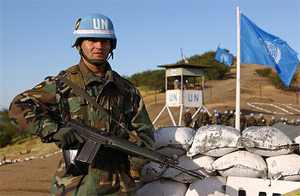
Bolivian "Blue Helmet" at an exercise in Chile, 2002
The UN, after approval by the Security Council, sends peacekeepers to regions where armed conflict has recently ceased or paused to enforce the terms of peace agreements and to discourage combatants from resuming hostilities. Since the UN does not maintain its own military, peacekeeping forces are voluntarily provided by member states. These soldiers are sometimes nicknamed "Blue Helmets" for their distinctive gear.[121][122] The peacekeeping force as a whole received the Nobel Peace Prize in 1988.[123]
In September 2013, the UN had peacekeeping soldiers deployed on 15 missions. The largest was the United Nations Organization Stabilization Mission in the Democratic Republic of the Congo (MONUSCO), which included 20,688 uniformed personnel. The smallest, United Nations Military Observer Group in India and Pakistan (UNMOGIP), included 42 uniformed personnel responsible for monitoring the ceasefire in Jammu and Kashmir. UN peacekeepers with the United Nations Truce Supervision Organization (UNTSO) have been stationed in the Middle East since 1948, the longest-running active peacekeeping mission.[124]
A study by the RAND Corporation in 2005 found the UN to be successful in two out of three peacekeeping efforts. It compared efforts at nation-building by the UN to those of the United States, and found that seven out of eight UN cases are at peace, as compared with four out of eight US cases at peace.[125] Also in 2005, the Human Security Report documented a decline in the number of wars, genocides, and human rights abuses since the end of the Cold War, and presented evidence, albeit circumstantial, that international activism—mostly spearheaded by the UN—has been the main cause of the decline in armed conflict in that period.[126] Situations in which the UN has not only acted to keep the peace but also intervened include the Korean War (1950–53) and the authorization of intervention in Iraq after the Gulf War (1990–91).[127]
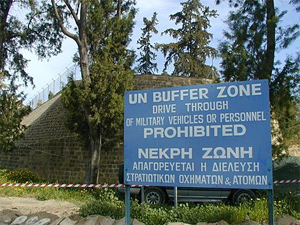
The UN Buffer Zone in Cyprus was established in 1974 following the Turkish invasion of Cyprus.
The UN has also drawn criticism for perceived failures. In many cases, member states have shown reluctance to achieve or enforce Security Council resolutions. Disagreements in the Security Council about military action and intervention are seen as having failed to prevent the Bangladesh genocide in 1971,[128] the Cambodian genocide in the 1970s,[129] and the Rwandan genocide in 1994.[130] Similarly, UN inaction is blamed for failing to either prevent the Srebrenica massacre in 1995 or complete the peacekeeping operations in 1992–93 during the Somali Civil War.[131] UN peacekeepers have also been accused of child rape, soliciting prostitutes, and sexual abuse during various peacekeeping missions in the Democratic Republic of the Congo,[132] Haiti,[133] Liberia,[134] Sudan and what is now South Sudan,[135] Burundi, and Ivory Coast.[136] Scientists cited UN peacekeepers from Nepal as the likely source of the 2010–13 Haiti cholera outbreak, which killed more than 8,000 Haitians following the 2010 Haiti earthquake.[137]
In addition to peacekeeping, the UN is also active in encouraging disarmament. Regulation of armaments was included in the writing of the UN Charter in 1945 and was envisioned as a way of limiting the use of human and economic resources for their creation.[94] The advent of nuclear weapons came only weeks after the signing of the charter, resulting in the first resolution of the first General Assembly meeting calling for specific proposals for "the elimination from national armaments of atomic weapons and of all other major weapons adaptable to mass destruction".[138] The UN has been involved with arms-limitation treaties, such as the Outer Space Treaty (1967), the Treaty on the Non-Proliferation of Nuclear Weapons (1968), the Seabed Arms Control Treaty (1971), the Biological Weapons Convention (1972), the Chemical Weapons Convention (1992), and the Ottawa Treaty (1997), which prohibits landmines.[139] Three UN bodies oversee arms proliferation issues: the International Atomic Energy Agency, the Organisation for the Prohibition of Chemical Weapons, and the Comprehensive Nuclear-Test-Ban Treaty Organization Preparatory Commission.[140]audiobooks)

